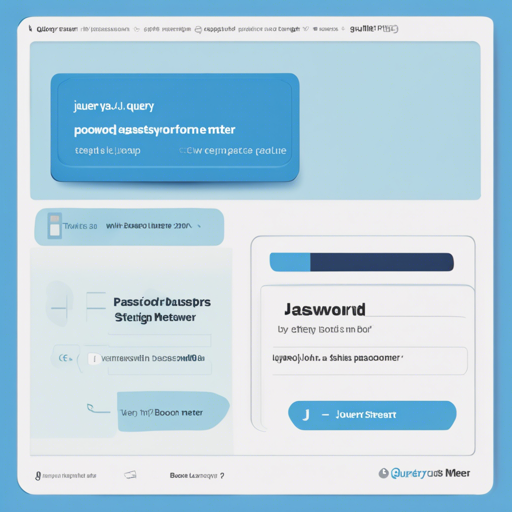Password security is paramount in today’s digital age, and ensuring that your users set strong, secure passwords is a critical aspect of web application development. The jQuery Password Strength Meter plugin for Twitter Bootstrap is a fantastic tool that visually displays the quality of passwords as users type them in. In this guide, we will dive into how to implement this plugin so that your application can effectively gauge password strength.
Installation Requirements
- jQuery 1.7 or higher
- Bootstrap 2, 3, 4, or 5
Downloading the Plugin
You can install the jQuery Password Strength Meter via various package managers. The easiest methods are through:
- Bower
- NPM
- Downloading directly from the repository
After downloading, ensure you include it in your HTML after the original jQuery and Bootstrap JavaScript files:
<script type="text/javascript" src="dist/pwstrength-bootstrap.min.js"></script>Initializing the Password Strength Meter
Once included, invoke the Password Strength Meter on your desired password input fields. For example, to apply it to all password fields:
$(:password).pwstrength();Alternatively, you can target a specific input and customize the options:
$('#passwd1').pwstrength({ ui: { showVerdictsInsideProgressBar: true } });Understanding Options and Methods
The Password Strength Meter is highly customizable. You can add unique rules, change scoring, activate or deactivate rules, and more. Here’s an analogy to illustrate how to work with options:
Imagine you’re a chef setting the rules for a cooking challenge. You get to decide what ingredients are allowed, how spicy the dish should be, whether certain tools (like a whisk or blender) are mandatory, and what criteria a dish must meet to be considered excellent. Similarly, the Password Strength Meter allows you to define rules that dictate how passwords should be assessed, helping you create a secure user experience.
Changing Rule Scores
You can change the score associated with a rule like so:
$('#passwdfield').pwstrength(changeScore, wordSequences, -100);Adding Custom Rules
If you want a custom twist, you can define your own rules too:
$('#passwdfield').pwstrength(
addRule,
'testRule',
function (options, word, score) { return word.match(/[a-z][0-9]/) ? score : 0; },
10,
true
);Callback Functions
The plugin also provides callback functions such as:
- onLoad
- onKeyUp
- scoreCalculated
For example, to display the current score dynamically:
$(document).ready(function () {
var options = {
onKeyUp: function (evt, data) {
$('#length-help-text').text('Current length: ' + $(evt.target).val().length + ' and score: ' + data.score);
}
};
$(':password').pwstrength(options);
});Troubleshooting
If you encounter issues, here are some troubleshooting ideas:
- Ensure that jQuery and Bootstrap scripts are properly linked.
- Check for JavaScript errors in your browser’s developer console.
- If the meter is not appearing, verify your selector and make sure it’s accurately targeting your password inputs.
- Read through the documentation for any missed setup steps.
For more insights, updates, or to collaborate on AI development projects, stay connected with fxis.ai.
Conclusion
Incorporating the jQuery Password Strength Meter into your forms is a proactive way to boost security and enhance user experience. With attractive, dynamic feedback on password strength, your users will be well-equipped to create robust passwords.
At fxis.ai, we believe that such advancements are crucial for the future of AI, as they enable more comprehensive and effective solutions. Our team is continually exploring new methodologies to push the envelope in artificial intelligence, ensuring that our clients benefit from the latest technological innovations.

